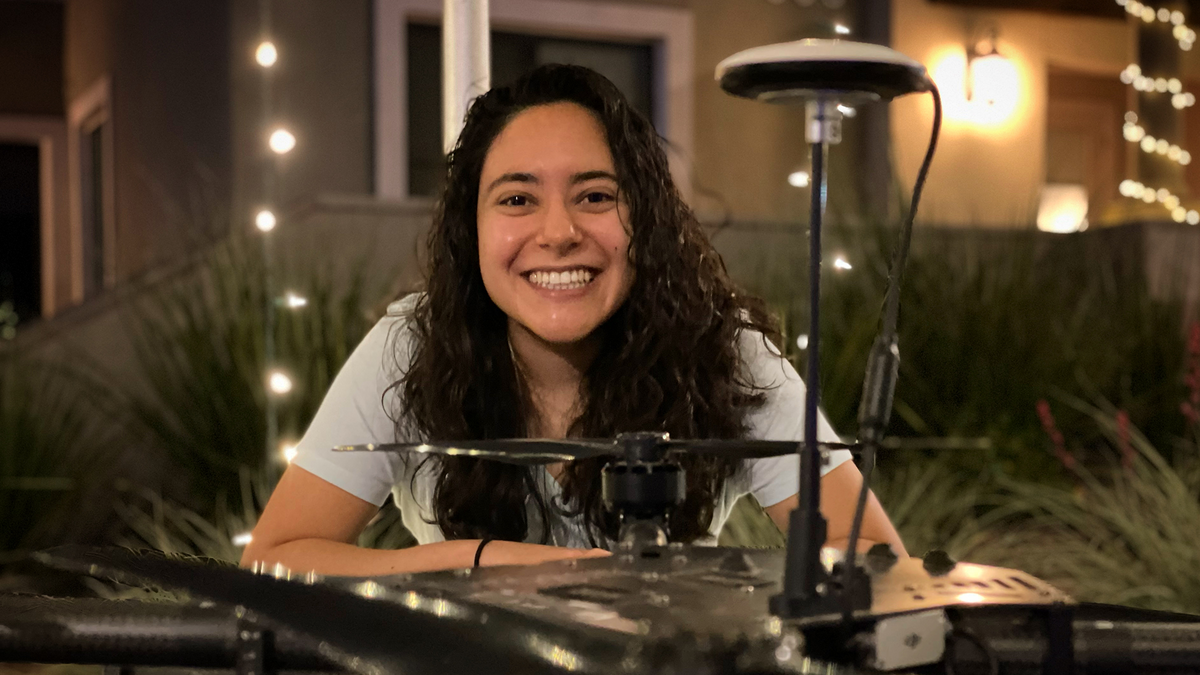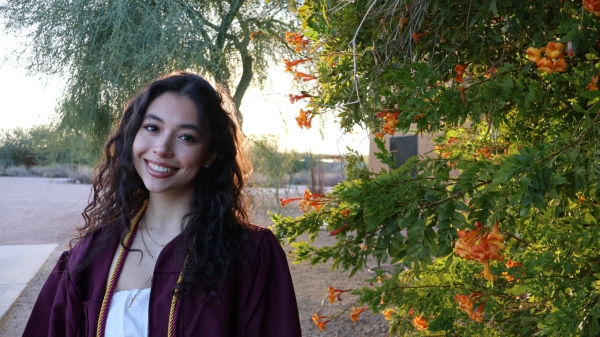Media arts and sciences PhD redesigns community through research in human-computer interaction

Photo courtesy of Alejandra Rodriguez Vega
Editor’s note: This story is part of a series of profiles of notable spring 2024 graduates.
Alejandra Rodriguez Vega, who is receiving her PhD from the media arts and sciences program in the School of Arts, Media and Engineering, focuses on designing with communities based on collaborative design approaches and user-centered design.
Rodriguez Vega has contributed valuable research to the local arts and academic communities during her graduate (MS and PhD) studies. Projects like “The Dream Collective” utilize crowdsourcing as a way to collect data about the experience of the modern classroom and how it can be re-designed to enhance the learning experience. She has also worked with Citizen Science to help design Pollinator Gardens for the local Mirabella at ASU community.
Rodriguez Vega credits Associate Professor Stacey K., in the School of Arts, Media and Engineering, and her as a source of inspiration for introducing her to the research area of human- computer interaction early in her graduate studies. Having the opportunity to help work behind the scenes for the 2019 Tangible Embedded and Embodied Interaction conference that took place at ASU’s Tempe campus inclined her to further pursue graduate studies with a PhD in media arts and sciences.
“I wanted to be a part of this and continue collaborating with these brilliant minds who are not only very technically gifted but also incredibly creative,” she said.
While Rodriguez Vega attributes acceptance into the PhD program to hard work and luck, her dedication to contributing her valuable perspective to the research fields stood out to faculty.
During her studies in the MS media arts and sciences program, she collaborated with the SANDS (Social and Digital Systems Group) research lab. This led to her finishing her MS with a publication that was published at the 2019 Designing Interactive Systems conference. This experience prepared her for the world of dissertation and defense that is typical within the realms of PhD studies.
“The paper focused on a workshop that we did with the community scientists, revolving around interaction with drones,” Rodriguez Vega said. “That was really the starting point of doing hands-on research, seeing the publication process, as well as presenting my research to my fellow peers, faculty and researchers from all over the world. And I was lucky enough that I had that experience during my first summer of my masters, so preparing to go into my PhD, I had a pretty good idea of at least how the first few years were going to be.”
Rodriguez Vega entered graduate studies with a background in communication and interest in the interactions that take place between humans and computer systems. She was able to explore these interactions in various ways, from co-developing an online creativity tool, “The Dream Collective,” and creating a friendly user interface, to holding in-person workshops with participants where users’ needs and aspirations for future technologies were brought to life through low-fidelity prototypes.
“I specifically decided to focus on what is called ‘collaborative design.’ This is an area of research that talks with all stakeholders and gives them the opportunity to iterate on any part of the design process and voice their concerns, desires and likes or dislikes,” she said. “The focus is really trying to understand user needs and expectations of designs and then working with engineers, designers and researchers to see how these changes can be brought to life. My research specifically focuses on integrating speculative methodologies into collaborative design so that participants are not limited by technological knowledge or feasibility when ideating and voicing their concerns, as well as, through online collaborative ideation tools, being able to collaborate with stakeholders at a larger scale.”
Most recently, Rodriguez Vega has worked on a project focused on collaborative design with the Center for the Future, an ASU-Starbucks partnership.
Rodriguez Vega has received multiple scholarships and awards through her studies, such as the Graduate Completion Fellowship (2023–24), Graduate College Travel Award (2022), Creative Constellation Grant (2021), University Graduate Fellowship (2020), Outstanding Graduating Student (2019) and Katherine K. Herberger Scholarship (2018).
Question: What’s something you learned while at ASU — in the classroom or otherwise — that surprised you or changed your perspective?
Answer: My original background was in the humanities, so I was really scared of all these coding classes and thought they were going to be math heavy. I quickly learned otherwise, and I especially thank the faculty at AME, as they help you understand the logic behind coding and how it can be applied to art and creative outlets. I don’t think that that was something that I have ever encountered before or even thought possible, so that was very interesting to learn and tackle.
Q: Why did you choose ASU?
A: It was actually the weather. I don’t think a lot of people would say that, but I do like the heat for one thing. On a more serious note, the biggest thing was I didn’t find any other universities or programs that had a similar program like media arts and sciences — where it’s not completely engineering and it’s not completely art — it’s a mixture of both as well as design. This was extremely attractive to me, because I don’t have a background in engineering and didn't have the pressure of going into it thinking ‘Oh no, I need to know how to code!’ This really helped me get in the door having a bit of an understanding in engineering, design and art. Now, with my experience through research, I can communicate with engineers and programmers along with designers to produce meaningful and user-friendly interactions.
Q: Which professor taught you the most important lesson while at ASU?
A: My PhD chair, Stacey K. Her extensive background in human computer interaction has been extremely eye-opening. It has also made me realize my passion so that was extremely helpful while doing my PhD. She has taught me to be a better writer and a better researcher and how to approach people, handle workshops, and how to analyze data. She has been essential throughout my PhD journey.
I also have to mention Professor Kimberlee Swisher, I was her teacher’s assistant for quite a bit and although I never took a class with her since she teaches undergrad, she really inspired me to be a better educator and mentor and understand how to relate to people better when tackling problems. Really, all the faculty and staff within AME deserve recognition as they are great in helping you find a solution. If you have a crazy idea or a random question, even if it’s really out there, they’ll ask for more details and help find a solution. This would not have been doable without such a supportive department.
Q: What’s the best piece of advice you’d give to those still in school?
A: My best advice would be to ask a lot of questions. A lot of times you hear faculty say go to office hours or if you have any questions, come up and ask me, I’ll be here and not a lot of people take that opportunity. What I’ve learned is that the amount of knowledge that everyone has is beyond what you expect and if you really want to make the most out of your time here, whether it’s undergraduate or graduate studies, start a conversation with faculty and staff, because they really do want to help you. Not only can this help you make connections, but it also helps you figure out what you want to do for a career.
Q: What was your favorite spot on campus, whether for studying, meeting friends or just thinking about life?
A: It was probably the graduate student lounge in Matthews Center (on the Tempe campus). I was able to meet my fellow grad students, and just being able to talk with them and hang out really helped with making friends but also understanding their approach to their own research and writing. I think one of the things that really separates graduate studies from undergraduate studies is that everyone is doing their own research, writing their own papers, so this can become lonely sometimes. Having the Matthews Center created a space where I could talk with other students and understand the struggles they're going through and how they tackled challenging times.
Q: What are your plans after graduation?
A: I am hoping to go into user experience research in industry. User experience research allows us to collaborate, ideate and design alongside stakeholders such as users, designers, engineers and programmers to see what works, what doesn’t work, and what can be improved in a current technology, service or experience and even speculate on the future.
Q: If someone gave you $40 million to solve one problem on our planet, what would you tackle?
A: I don’t think $40 million would be enough to tackle a specific problem on our planet. However, I do think a way to start tackling a lot of problems would be by educating people, so one of the things I think we could heavily invest in would be in education. I think now more than ever, teachers and middle school teachers lack funding and support. This money could be used to give teachers and students a better starting point to further educate them and have them be aware of problems and ways to solve the problems. Not just getting information out about things like global warming but actually giving them the time and resources to solve the problems through collaborative work. Education can be a great starting point or a foundation to actually solve problems.
More Sun Devil community

Passion for human behavior drives first-gen student to major in psychology
Editor’s note: This story is part of a series of profiles of notable fall 2024 graduates.Natalie Motta is a driven and accomplished young woman who embodies resilience, ambition and a…

ASU grad turns interest in true-crime podcasts into passion for forensic psychology
Editor’s note: This story is part of a series of profiles of notable fall 2024 graduates.Kymberlin Quackenbush exemplifies resilience and ambition as she prepares to graduate from ASU’s New…

ASU grad combines academics, public service and entrepreneurship
Editor’s note: This story is part of a series of profiles of notable fall 2024 graduates.As a youngster, Javier Aguirre Martinez lived at the House of Refuge, next to the Arizona State…